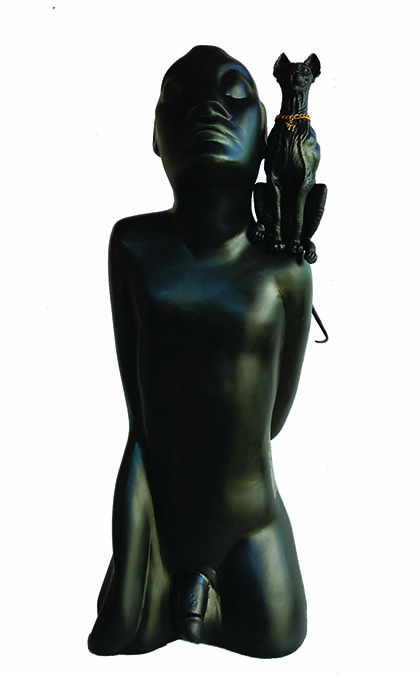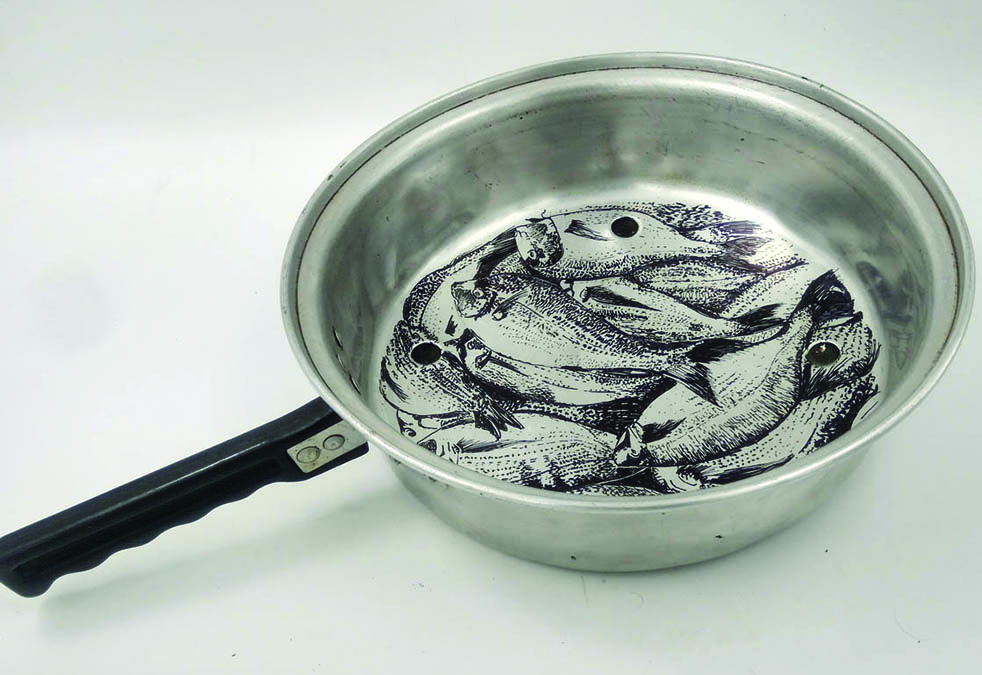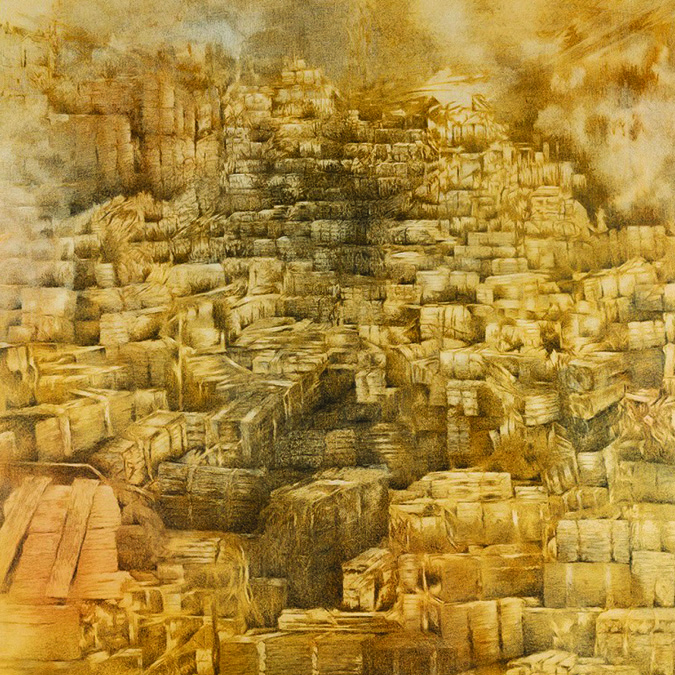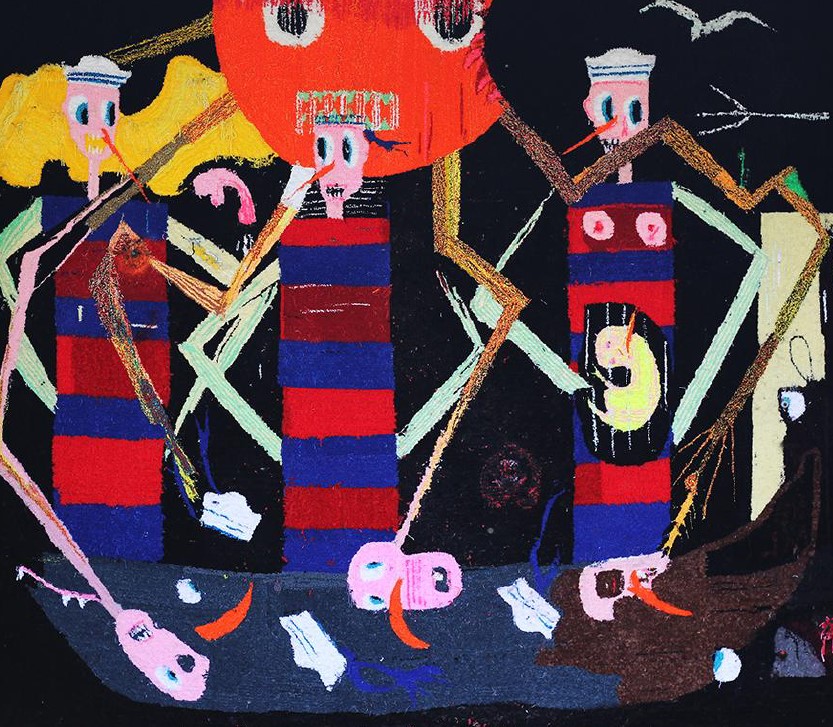-
אוצרסורין הלר
-
אמניםתערוכה בינלאומית
-
מועד התערוכה08.10.22 - 31.12.22
טקסט בעברית- בעקבות הזיכרון האבוד
In Search of Lost Memory –טקסט באנגלית
בעקבות הזיכרון האבוד
התערוכה "בעקבות הזיכרון האבוד", שבה מציגים אמנים מלודז' (פולין), ניו אורלינס (לואיזיאנה, ארה"ב) וישראל, היא הפרק השלישי בפרויקט זיכרון שיזמה האמנית האמריקנית רובין לוי מתוך רצון ליצור מהלך של תיקון לזיכרון הטראומטי בילדות של אִמה, שורדת שואה מלודז'.
הפרק הראשון של הפרויקט התקיים בלודז'. הפרק השני הוצג בניו אורלינס והפגיש אמנים מקומיים עם אמנים מלודז', אשר יחדיו התייחסו לנקודת ציון בזיכרון שהניב שיח על תפקידה של האמנות בשימור ושחזור הזיכרון.
הפרק הנוכחי – "בעקבות הזיכרון האבוד" – בוחן את האופן שבו מחוללת האמנות זיכרון תקשורתי ותרבותי שבאמצעותם נבנה הזיכרון הקולקטיבי (Assmann, 2011). חוויות וסיפורים אישיים, פולחנים, אמונות, טראומות, דמיון ותכנים מהתת-מודע העולים מתוך ההתייחסות לטבע ולסביבה עירונית הם חומרי הגלם בתוך ארגז הכלים של האמן. השימוש בכלים כגון אלה, באמצעות פרקטיקות אמנותיות של פירוק, הריסה ובנייה מחדש, יוצרים סיפור על הזיכרון. רוב העבודות הוצגו בעבר – יתר על כן, הן רכיבים מתוך תערוכות שביטאו מהלך מסוים ביצירתם של האמנים – אך כאן הן חלק מנרטיב חדש המעשיר את הפרשנות על העבודות.
בדומה לזיכרון המותנה בזמן ובמקום, ממשיים או בדיוניים, גם הסיפור ונע בין זמנים שונים, בין כאן ועכשיו לבין שם ואז, לטענתו של אסמאן, הוא נשען על הבניות חברתיות ותרבותיות, וכך הסיפור על הזיכרון הוא בעצם סיפור על זהות.
הנרטיב המרובד המתהווה בתערוכה מטשטש את הגבולות הגיאוגרפיים והתרבותיים בין האמנים.יות ויוצר מעין בבואה של הלך רוח משותף כחלק מתהליכי הגלובליזציה. קריאת הנרטיב מבקשת פעולה של פירוק ובנייה. תחילתהּ בחלוקה לקטגוריות לחיפוש המשותף וניסיון להגדרתו, ומתוך כך מסתמן עיסוק במספר טריטוריות המשמשות נקודת מוצא לפעולת היצירה והמקפלות בתוכן זמן ומקום. טריטוריות אלה מרובדות. חלקן ממשיות, כמו בית ההורים, אזור גיאוגרפי תרבותי ופוליטי במצב של קונפליקט, בעוד אחרות אינן ממשיות אלא מתקיימות בתת-מודע או מדומיינות אך הן בעלות זיקה לזיכרון האישי וההיסטורי. ניתן למצוא אמנים.יות שיצירותיהם נעות בין כמה טריטוריות.
אחת הטריטוריות שרבים מהאמנים.יות עוסקים.ות בה היא זיכרונות ילדות, חלקם טראומטיים. כך למשל, "המערה", יצירתה של אגניישקה צ'וצ'נצה, היא מיצב העשוי מכיסאות של כיתה ושמיכות, כדרכם של ילדים, שבה בעת הוא ידידותי ומזמין להיכנס אך הופך למאיים ברגע הצפייה בסרט הווידיאו. מריק לכנר, יליד צ'רנוביץ (אוקראינה), אורג את זיכרונות הילדות במסורת שטיחי הקיר ואיורים של מזרח אירופה. שיבוטיו של פינוקיו לובשים פנים רבות של גבר, אישה, עובר וגולגלות היוצרים מעגל חיים בין לידה למוות. עבודתו יוצרת שיח על מעמדו של הקראפט בהקשר של אמנות "גבוהה". מרתה מדג'סקה ליוותה את פרויקט הזיכרון בלודז' ובניו אורלינס, והקליטה את זיכרונות הילדות של אן סקורצקי לוי (נוסיה), אִמה של רובין לוי. פעולת ההקלטה חיברה בין העבר להווה ושימשה מעין תיקון, ריפוי לזיכרון הטראומטי מלודז'. רובין לוי, המשוועת לתיקון הזיכרון הטראומטי של אִמה, מציבה בלונים כייצוג של ילדות; הוורוד היה הצבע האהוב על אִמה בילדותה, ועל הבלונים מודפסים תצלומי ילדות של אִמה. לוי נוקטת כאן בפעולה של פרשנות הזיכרון של אִמה והעתקתו (Relocation) מלודז' לברעם. סרטו של פיוטר שצ'פנסקי עוסק בניסיון להגדיר רצף של זמן, רצף של התרחשויות מהילדות על מנת לדלות זיכרונות היוצרים מתח במפגש עם ההווה.
בית הילדות הוא טריטוריה המשמשת נקודת מוצא לעבודותיהן של יעל אפרתי וג'סטינה ואנסל. אפרתי מתייחסת לזיכרון ילדות של מפגשים עם שכנה קשישה בשם גברת ת'ור, שנשענה על מקל הליכה. ביצירתה מתלכדים שער הכניסה לחצר ומקל ההליכה ליחידה אחת. אפרתי בוחרת לתרגם את שער הברזל לחומר קרמי מצופה גרפיט כסוג של העתקה בזמן של הזיכרון. ואנסל, העוסקת ביצירתה בזהות נשית, חוזרת אל בית ילדותה הנטוש ומתייחסת אליו כאל ארכיון שבאמצעות פעולות טקסיות ניתן להתחקות בו אחר תכונות נשיות תורשתיות במשפחתה.
דבורה לוסטר ולואיס קרוז אזאצטה עוסקים בשימור זיכרון בתודעה הקולקטיבית של אירועים טראומטיים. לוסטר התחקתה אחר ארכיון משטרתי בניו אורלינס, ותיעדה זירות רצח שבהן רוב הקורבנות הם אפרו-אמריקנים. אזאצטה מתייחס לאזורי עימות בעיראק, בסוריה ובעזה ומתאר, לצד הפליטוּת, את משחק המעצמות המעצבות מחדש מדינות שעלולות לקרוס כמו ארמונות חול.
הארכיון משמש כטריטוריה המשמרת את העבר ואשר ממנה דולים האמנים זיכרונות. עבור ראובן זהבי משמש הארכיון מאגר ליצירת דימויים הנשענים על תצלומים של עובדות מין, חלקן יהודיות, מרובע בוסביר (Bousbir) שהצרפתים הקימו בקזבלנקה בראשית שנות העשרים של המאה הקודמת ואשר פעל כפארק תיירות מין הגדול מסוגו בעולם. זהבי בוחן האם וכיצד מאפשר הארסנל האמנותי האישי של הרישום והציור התמודדות עם זיכרון קולקטיבי-היסטורי, ומעלה לדיון שאלות אתיות על השימוש בדימויי עבר קולוניאליים. ניתן לקשור את יצירתו של זהבי לקבוצה של אמנים העוסקים בחומר ארכיוני כנקודת מוצא וכתיעוד בדומה ללוסטר ו-ואנסל. דור גז יוצר הקשר חדש לדימויים שנלקחו מאוספים של אלבומי פרחים מיובשים בארכיון של המושבה האמריקאית בירושלים, בסדרת "חבצלות השדה", ותצלום סבתו סמירה שנלקח מהארכיון של המושבה הנוצרית-פלסטינית ביפו, המופיעה גם בסרט "סאביר". הוא מוציא אותם מהֶקְשר התיעוד המדעי של צמחייה מקומית (חלקם אף אינם מקומיים) ומכניס אותם להקשר חדש המהדהד את פעולת העקירה לצד הגעגוע למקום ולזמן אידיאליים-כביכול, שגם הם נמצאים תחת איום. קורטני איגן & אניטה ישאו, שנקודת המוצא שלהן היא נתונים ממחלקת המקרקעין של ניו אורלינס, בוחנות את השינויים הסוציו-דמוגרפיים בתוך הגוש. הן מנסות להעשיר את הזיכרון ההיסטורי המתועד באמצעות הוספת הקול האנושי ושיתוף פעיל של הצופה. הטריטוריה של הדר גד היא זיכרון היסטורי, פרטי וקולקטיבי, השאוב מחומרים ארכיונים. הטריטוריה אינה מקום ספציפי, וגם הייצוגים שנבזזו או נהרסו מתקיימים רק בזיכרון. הספרים, החפצים, ההתרחשות והמקום נכחדו על ידי הנאצים אך נשמרו בזיכרון הקולקטיבי; באמצעות פעולת הציור יוצרת גד מעין שחזור של זיכרון באמצעות בניית שכבות צבע וחזרה בזמן על ידי גירוד וגריעה, כמעין חשיפת שכבות ארכיאולוגיות של הזיכרון.
ניתן להצביע בתערוכה גם על פרקטיקת אמנות של ניכוס תרבותי מנקודת מבט ביקורתית ויכולתו להתקיים, המותנית בזיכרון התרבותי הקולקטיבי. דוד עדיקא מציג שני תצלומים מסדרת "שוק שחור" המתארים פיגורינות שנוצרו במפעל, נצבעו בשחור וצולמו לאור השמש. התצלומים מעוררים זיכרון תרבותי של ה"ביז'ו", אותם פסלוני חרסינה בתרבות האירופאית שהפכו לשחורים. עדיקא מלביש "מסכה שחורה" על תרבות מערבית, ובכך מעלה שאלות על ניכוס תרבותי, טעם, ערך ותפקיד האמן. אייל אסולין מתייחס בפסלו "מוטי" לזיכרון התרבותי של האמנות הישראלית, ומייצר פרשנות לפסלו של יצחק דנציגר, "נמרוד", הנחשב לאחת מאבני היסוד של קאנון האמנות המקומית. הפסל "מוטי", הקורא תיגר על התפיסה ההגמונית המערבית של יחסי הכוחות בשדה התרבותי, עשוי מחומר תעשייתי זול ולא מאבן חול נובית כמו הפסל "נמרוד". צבעו השחור של "מוטי" הופך אצל אסולין לייצוג של ה"אחר".
טריטוריה נוספת היא מקום ספציפי בעל הגדרה גיאוגרפית. ג'ון אייזיה וולטון מתייחס ללואיזיאנה ולניו אורלינס ובוחן בהן סוגיות של זהות הכוללות ממשוּת ובלתי נראוּת, נוכחוּת והיעדרוּת, קיימוּת ורִיק. ציוריו מקודדים בדימויים וסמלים שניתן לפענחם באמצעות היכרות עמוקה עם השדה התרבותי-מקומי. בדומה לוולטון, גם קרל ג'ו וויליאמס מתייחס ביצירתו לסביבה הקרובה, ניו אורלינס. באיורים לספרה של קתי ז' פרייס, "מארדי גרא כמעט לא הגיע השנה", 2022, מתאר וויליאמס את חוויית חידוש קרנבל "מארדי גרא" לאחר הפסקה בשל הוריקן קתרינה. מקור גיבורי איוריו הם אבותיו ואימהותיו האפרו-אמריקנים, ובאמצעותם הוא קורא תיגר על אפליה וגזענות על רקע צבע עור ומוצא. אשרף פואחרי ממקם את יצירתו בטריטוריה היסטורית, תרבותית ופוליטית וגיאוגרפית – ישראל. דימוי החמור, שאותו אימץ כייצוג של האישי והקולקטיבי הפלסטיני, מאוים כטרף לצׇבועים. בטקסט המצויר "אם נישאר בלי זיכרון יאכלו אותנו הצבועים" הוא מעניק לזיכרון ההיסטורי והתרבותי את הכוח המגן מפני ההיטמעות.
טריטוריה מסוג אחר היא זו המתקיימת רק בדמיונו של הצופה ו/או בתת-מודע שלו. יצירתה של אתי אברג'יל "Fragile Cosmic Love" היא מעין מסע בדיוני של חיפוש אחר אהבה אבודה, המתקיים ביקום ובתת-מודע של הצופה. העבודה מבטאת את הערגה להגיע אל המקום תוך ידיעה שהפעולה מלֻווה בסכנה, בפגיעוּת ובחרדה. מצד אחד, חומריות העבודה מעוררת בצופה את הרצון לקלף, לחפור, לגלות את השכבות, ומצד שני מעוררת בו תחושת השבריריות את הפחד לשבור, להרוס או לאבד. סדרתה של אורית ישי, "יער הזיכרון" שבו מוצגים תצלומים דיגיטליים של שקופיות של ניתוחי עיניים מעובדות, עוסקת בחקר תהליך הראייה הנע בין העין למיקרוסקופ ולמצלמה, והתוצר הצילומי הוא מעין דימוי שהצופה חובר אליו כזיכרון אישי. יהודית סספורטס, בסדרה "קרע קוסמי", מרבדת באמצעות מיפוי, סימון וקידוד אירועים טראומטיים מהעבר המתקיימים רק בטריטוריה של שפת האמנות מכיוון שהשפה המילולית אינה יכולה להכיל אותם. בדומה לאברג'יל, הטריטוריה מתקיימת ביקום ובתת-מודע של הצופה. בתהליך הפענוח של היצירה, מותירה פעולת הרישום את הצופה במצב של חוסר אונים בין הממשי לבדיוני, המשכפל את עצמו שוב ושוב.
מגוון הטריטוריות מצביע על פרקטיקות שונות שבהן האמנים.יות מתייחסים.ות לזיכרון והם הרכיבים שמהם נבנה הסיפור, התערוכה. החיבורים שטווה הסיפור בין תרבויות מבטאים קולות מגוונים שמתוכם עולות סוגיות של זהות, קיפוח, גזענות, סכסוכים לאומיים, פליטוּת, רצח עם והגירה, הנבחנות מנקודת מבט ביקורתית. הכאב העולה וצף מתוך היצירות משווע להכרה ולתיקון, ומביע משאלה שאולי ביכולתה של האמנות להביא לריפוי.
סורין הלר
In Search of Lost Memory
In the exhibition “In Search of Lost Memory,” works by artists from Lodz, Poland; New Orleans, Louisiana, USA; and Israel comprise the third chapter of the Memory Project initiated by American artist Robin Levy based on her desire to create tikkun –repair and rectification – of traumatic childhood memories of her mother, a Holocaust survivor from Lodz.
The first chapter of the Memory Project took place in Lodz, while the second was exhibited in New Orleans in an encounter between local artists and Polish artists from Lodz. Together they referred to the orienteering coordinates of memory, generating a discourse on the function of art in preserving and recreating memory.
The current chapter in the Bar-David Museum, Baram, Israel, “In Search of Lost Memory,” examines the way in which art produces a communicative and cultural memory through which collective memory is structured (Assmann, 2011). Personal experiences and stories, rituals, beliefs, traumas, imagination and contents from the subconscious arising from addressing nature and the urban environment are the raw materials in the artist’s toolbox. Using tools such as these, combined with practices such as deconstruction, destruction, and reconstruction, create a narrative of memory. Most of the works were exhibited in the past, elements from previous exhibitions that expressed a certain stage in the artists’ oeuvre – but here they form part of a new narrative enriching the interpretation of the works.
Similar to a memory conditional on time and place, concrete or fictional, the story moving between different eras, between the “here and now” and the “there and then,” as Assman stated, the narrative of memory depends on the sociocultural restructuring, and is thus a narrative of identity. The multilayered narrative forming through the exhibition blurs the geographical and the cultural borderlines between the artists to go past limits, reflecting their shared mood as part of the globalization processes. Reading the narrative calls out for an act of deconstruction and construction. Its beginning lies in the division into categories for the joint search and the attempt to define it, turning out to be an engagement in several territories serving as the point of origin for the creative act enfolding time and place. These territories are multileveled: some are concrete, like the parental home, or a geographic, cultural, and political conflict zone, while others are not concrete but exist in the subconscious or the virtual realm. However, they do have an associated to individual and historical memory. We can find artists whose works move between several territories.
One of the territories in which many of the artists have engaged is the realm of childhood memories, some of which are traumatic. One example is Cave (2012) by Agnieszka Chojnacka, an installation made of schoolroom chairs and blankets, as children make, looking simultaneously friendly and inviting, but which becomes threatening as soon as the visitor watches the video. Marik Lechner (b. Czernowitz, Ukraine) weaves his childhood memories through traditional tapestry technique using wool and polyester, evoking Eastern European illustrations. The reincarnations of Pinocchio have numerous faces: a man, woman, fetus, and skulls creating a cycle of life between birth and death. His work leads to a discussion on the status of craft in the context of “high art.” The sound piece by Marta Madejska, Nusia at the Crossroads (2022), accompanied The Memory Project from Lodz to New Orleans, as she recorded the memories of Robin Levy’s mother Anne (Nusia) Skorecki Levy. The taping connected the past to the present acting to heal and repair the traumatic memory from Lodz. Robin Levy, crying out to repair her mother’s traumatic memory, has installed balloons as a representation of childhood. The balloons are pink, her mother’s favorite color as a child, imprinted with photographs of Nusia as a child. Relocating her mother’s memory from Lodz to Baram is an interpretive act. Memory Project (2012), the film by Piotr Szczepanski, engages in the attempt to define a time continuum of events from childhood to sift out memories that create the tension in the encounter with the present.
The childhood home is a territory which is the starting point for works by Yael Efrati and Justyna Wencel. Efrati refers to her childhood memory of encounters with Mrs. Thor, an elderly neighbor who used a cane to walk. The iron entrance gate to the yard and the cane become one in the video, as the gate is translated into ceramic material covered with graphite powder in a kind of relocation of memory in time. Wencel, whose work engaged in feminine identity, returns to her abandoned childhood home, treating it like an archive. Through ritual actions, it can be used for tracing the hereditary feminine traits in her family.
Deborah Luster and Luis Cruz Azaceta both made works on how collective memory of traumatic events is preserved. Luster followed the New Orleans Police Archive and documented crime scenes in which the majority of victims were African-Americans. Archives are a territory preserving the past from which the artists draw memories. For Reuven Zahavi, the archive serves as a pool from which to create images based on photographs of sex workers, some of whom are Jewish women, from the Bousbir Quarter the French established in Casablanca in the early 1920s. It was the largest sex tourism park of its kind in the world. Zahavi examines if and how the personal artistic arsenal of drawing and painting address historical-collective memory, raising ethical issues for discussion about the use of images from the colonial past. Zahavi’s oeuvre can be associated with the group of artists who use archival materials as the impetus for their work and as documentation, as do Luster and Wencel. Dor Guez creates a new association to images taken from albums of dried flowers in the archive of the American Colony, Jerusalem, in his series “Lilies of the Field,” and the photograph of his grandmother Samira taken from the archive of the Christian Palestinian Colony in Jaffa, also appearing in the video film Sabir. He extracts them from the context of scientific documentation of local flora (some of which are not even local) and recontextualizes them, resonating the act of uprooting along with the yearning to a seemingly ideal place and time that are also threatened.
Courtney Egan & Anita Yesho used data from the Land Records of New Orleans for their starting point in the examination of the social-demographic changes in the neighborhoods. The duo attempted to enrich the documented historical memory by adding the human voice and the viewer’s active collaboration. Hadar Gad’s territory is historical, individual, and collective memory extracted from archival materials. The territory is not a specific location, while the representations of the looting and destruction exist in memory only. The books, objects, events, and the location were erased by the Nazis but were preserved in collective memory; through the act of painting and scraping layers, Gad seems to recreate construction, returning in time by taking off layers, excavating and exposing archaeological layers of the memory.
Other works in the exhibition critical of cultural appropriation and its existence, which is conditional on the collective cultural memory. David Adika is exhibiting two photographs from his series “Black Market” depicting factory-fabricated figurines which he painted black and photographed in direct sunlight. The photographs arouse the cultural memory of the “bijou,” porcelain figurines prized in European culture which Adika colors black. Adika places a “black mask” onto western culture, thus bringing up issues of cultural appropriation, taste, value, and the artist’s role. Eyal Assulin refers to the cultural memory of Israeli art through his sculpture Moti, interpreting Yizhak Danziger’s Nimrod, considered one of the pillars of the local art canon. Moti challenges the hegemonic western perception of cultural power relations, as it is made of cheap industrial material instead of Nubian sandstone like Nimrod. Moti has thus become Asulin’s representation of the “other.”
Territory can also be a specific location with a geographic definition. John Isiah Walton explores issues of identity in his home city of New Orleans and in Louisiana, comprising concreteness and invisibility, presence and absence, existence and emptiness. His paintings are encoded with imagery and symbols that can be decoded through getting to know the local cultural scene in-depth. Carl Joe Williams also refers in his work to his immediate environment – New Orleans. In the drawings for Cathy Z. Price’s book, Mardi Gras Almost Didn’t Happen This Year, 2022, Williams depicts the experience of reviving the Mardi Gras Carnival which was cancelled since Hurricane Katrina. The heroes are his African-American ancestors through which he challenges the discrimination and racism based on skin color and ethnicity. Ashraf Fuahri places his artwork in historical, cultural, and geopolitical territory – in Israel. The image of the donkey that he adopted as the representation of the individual and collective Palestinian, is threatened by hyenas who attempt to prey on it. The illustrated text, “If we remain without a memory, the hyenas will eat us,” imbues historical and cultural memory with the protective power against assimilation.
Territory of another type exists only in the viewer’s imagination and/or their subconscious. Etti Abergel’s Fragile Cosmic Love is a virtual quest for lost love, taking place in the universe and in the viewer’s imagination. The work expresses yearning to reach that place knowing that the action is accompanied by danger, vulnerability, and anxiety. On one hand, the materiality of the artwork stimulates the viewer’s desire to peel, dig down, and reveal layers, while on the other hand it arouses in the viewer a sensation of the fragility and the fear of breakage, destruction, and loss. “Forest of Blindness” (2013), the series by Orit Ishay, displays digitally printed archival inkjet photographs of treated slides of eye operations in her research on the process of vision moving between the eye, microscope, and camera. The photographic outcome is a kind of image to which the viewer is connected as an individual memory. Yehudit Sasportas, in her series “Cosmic Rift No. 2” (2009) speaks through mapping, marking, and coding traumatic events from the past that exist solely in the territory of the language of art, since verbal language is unable to contain them. Similar to Abergel, the territory exists in the universe and in the viewer’s subconscious. In the process of decoding the work of art, the act of drawing leaves the viewer helpless between the concrete and virtual, replicating itself again and again.
The range of territories points to various practices through which the artists refer to memory, forming the elements from which the narrative is built – the exhibition. The connections that the story wove between cultures reflect varied voices out of which different issues of identity, deprivation, racism, national conflicts, refugeehood, genocide, and emigration are critically examined. The pain that arises and floats up from within the works cries out for recognition and rectification, expressing a deep wish that perhaps art has the capacity to bring about its healing.
Sorin Heller
Exhibition Curator
לסרט שיח הגלריה שנערך ב10.4.23 לחץ כאן
-
אוצרסורין הלר
-
מועד התערוכה08.10.22 - 31.12.22
-
אמניםתערוכה בינלאומית






